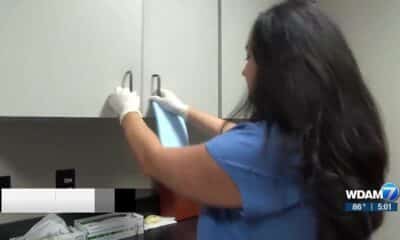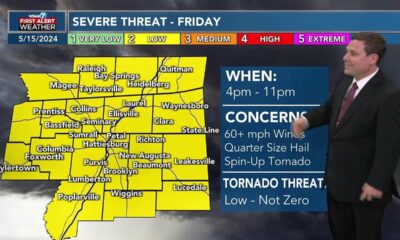Kaiser Health News
Deep Flaws in FDA Oversight of Medical Devices, and Patient Harm, Exposed in Lawsuits and Records
Fred Schulte, KFF Health News and Holly K. Hacker
Thu, 21 Dec 2023 10:00:00 +0000
Living with diabetes, Carlton “PeeWee” Gautney Jr. relied on a digital device about the size of a deck of playing cards to pump insulin into his bloodstream.
The pump, manufactured by device maker Medtronic, connected plastic tubing to an insulin reservoir, which Gautney set to release doses of the vital hormone over the course of the day. Gautney, a motorcycle enthusiast, worked as a dispatcher with the police department in Opp, Alabama.
The 59-year-old died suddenly on May 17, 2020, because — his family believes — the pump malfunctioned and delivered a fatal overdose of insulin.
“There's a big hole left where he was,” said Gautney's daughter, Carla Wiggins, who is suing the manufacturer. “A big part of me is missing.”
The wrongful-death lawsuit alleges the pump was “defective and unreasonably dangerous.” Medtronic has denied the pump caused Gautney's death and filed a court motion for summary judgment, which is pending.
The pump Gautney depended on was among more than 400,000 Medtronic devices recalled, starting in November 2019, after the company said in a recall notice that damage to a retainer ring on the pump could “lead to an over or under delivery of insulin,” which could “be life threatening or may result in death.”
As the recall played out, federal regulators discovered that Medtronic had delayed acting — and warning patients of possible hazards with the pumps — despite amassing tens of thousands of complaints about the rings, government records show.
Over the past year, KFF Health News has investigated medical device malfunctions including:
- Artificial knees manufactured by a Gainesville, Florida, company that remained on the market for more than 15 years despite packaging issues that the company said could have caused more than 140,000 of the implants to wear out prematurely.
- Metal hip implants that snapped in two inside patients who said in lawsuits that they required urgent surgery.
- Last-resort heart pumps that FDA records state may have caused or contributed to thousands of patient deaths.
- And even a dental device, used on patients without FDA review, that lawsuits alleged has caused catastrophic harm to teeth and jawbones. CBS News co-reported and aired TV stories about the hip and dental devices.
The investigation has found that most medical devices, including many implants, are now cleared for sale by the FDA without tests for safety or effectiveness. Instead, manufacturers must simply show they have “substantial equivalence” to a product already in the marketplace — an approval process some experts view as vastly overused and fraught with risks.
“Patients believe they are getting an implant that's been proven safe,” said Joshua Sharlin, a former FDA official who now is a consultant and expert witness in drug and medical device regulation. “No, it hasn't,” Sharlin said.
And once those devices reach the marketplace, the FDA struggles to track malfunctions, including deaths and injuries — while injured patients face legal barriers trying to hold manufacturers accountable for product defects.
In a statement to KFF Health News, the FDA said it “has a scientifically rigorous process to evaluate the safety and effectiveness of medical devices.”
‘Too Little, Too Late'
The FDA approved the MiniMed 670G insulin pump on Sept. 28, 2016, after its most stringent safety review, a little-used process known as premarket approval.
In a news release that day, Jeffrey Shuren, who directs the FDA's Center for Devices and Radiological Health, lauded the device as a “first-of-its-kind technology” that would give patients “greater freedom to live their lives” and to monitor and dispense insulin as needed. The pump was tested on 123 patients in a clinical trial over several months with “no serious adverse events,” the release said. Shuren declined to be interviewed.
The FDA's enthusiasm didn't last. In November 2019, Medtronic, citing the ring problem, launched an “urgent medical device recall” of the pumps, which it expanded in late 2021.
During an inspection at Medtronic's plant in Northridge, California, FDA officials learned the company had logged more than 74,000 ring complaints between 2016 and the November 2019 recall. More than 800 complaints weren't investigated at all, according to the FDA, which sharply criticized the company in a December 2021 warning letter.
Medtronic is facing more than 60 lawsuits filed by injured patients and their families and the company believes it may be hit with claims for damages from thousands more patients, the company disclosed in an August Securities and Exchange Commission filing.
Medtronic pumps that allegedly dispensed too much, or too little, insulin have been blamed for contributing to at least a dozen patient deaths, according to lawsuits filed since 2019. Some cases have been settled under confidential terms, while others are pending or have been dismissed. Medtronic has denied any responsibility in response to the lawsuits.
In one pending case, a Las Vegas man using the pump allegedly fell into an “insulin-induced coma” that led to his death in 2020. In another 2020 case, a 67-year-old New Jersey resident collapsed at her home, dying later the same day at a local hospital.
The recall notice Medtronic sent to a 43-year-old Missouri man's home arrived a few days after police found him dead on his bedroom floor, his family alleged in a lawsuit filed in August. “Simply too little, too late,” the suit reads. The case is pending, and Medtronic has yet to file an answer in court.
Medtronic declined to answer written questions from KFF Health News about the pumps and court cases. In an emailed statement, the company said it replaced pump rings with new ones “redesigned to reduce the risk of damage” and “fulfilled all pump replacement requests at no cost to customers.”
In April, Medtronic announced that the FDA had lifted the warning letter a few days after it approved a new version of the MiniMed pump system.
Shortcut to Market
The 1976 federal law that mandated safety testing for high-risk medical devices also created a far easier — and less costly — pathway to the marketplace. This process, known as a 510(k) clearance, requires manufacturers to show a new device they plan to sell has “substantial equivalence” to one already on the market, even if the prior product has been recalled.
Critics have worried for years that the 510(k)-approval scenario is too industry-friendly to protect patients from harm.
In July 2011, an Institute of Medicine report concluded that 510(k) was “not intended to evaluate the safety and effectiveness of medical devices” and said “a move away from the 510(k) clearance process should occur as soon as reasonably possible.”
More than a decade later, that hasn't happened, even amid mounting controversy over the clearance of hundreds of devices that employ artificial intelligence.
The FDA now clears about 3,000 low- to moderate-risk devices every year through 510(k) review, which costs the device maker a standard FDA fee of about $22,000. That compares with about 30 approvals a year through the stricter premarketing requirements, which cost nearly $500,000 per device, according to FDA data. Diana Zuckerman, president of the National Center for Health Research, said even many doctors don't realize devices cleared for sale typically have not undergone clinical trials to establish their safety.
“Doctors are shocked to learn this,” she said. “Patients aren't going to know it when their doctors don't.”
3,000
Approximate number of low- to moderate-risk devices cleared every year through 510(k).
30
Approximate number of devices receiving original approval from the FDA each year through stricter premarketing requirements.
In response to written questions from KFF Health News, the FDA said it “continues to believe in the merits of the 510(k) program and will continue to work to identify program improvements that strengthen the safety and effectiveness of 510(k) cleared devices.” The FDA keeps a tight lid on data showing which devices manufacturers choose to demonstrate substantial equivalence — what the agency refers to as “predicate” devices.
“We can't get detailed data,” said Sandra Rothenberg, a researcher at the Rochester Institute of Technology. “It's very hard for researchers to determine the basis on which substantial equivalence is being made and to analyze if there are problems.”
Rothenberg cited the history of “metal-on-metal” artificial hip implants, which under 510(k) spawned many new brands — along with a disastrous toll of patient injuries. The implants could release metal particles that damaged bone and led to premature removal and replacement, a painful operation. Just four of these hip devices have been the target of more than 25,000 lawsuits seeking damages, court records show. In early 2016, the FDA issued an order requiring safety testing before approving new metal-on-metal hip devices.
Alarm Bells
Two former Medtronic sales executives in California argue in a whistleblower lawsuit that the 510(k) process can be abused.
According to the whistleblowers, the FDA approved the Puritan Bennett 980, or PB 980, ventilator in 2014 based on the assertion it was substantially equivalent to the PB 840, an earlier mechanical ventilator long viewed as the workhorse of the industry.
Medtronic's subsidiary company Covidien made its claim even though the device has completely different “guts” and operates using software and other “substantially different” mechanisms, according to the whistleblowers' suit.
In response, Medtronic said it “believes the allegations are without merit and has moved to dismiss the case.” The case is pending.
The whistleblowers argue the PB 980 ventilator was plagued by dangerous malfunctions for years before its recall in late 2021.
One ventilator billowed smoke in an intensive care unit while the whistleblowers were told by one hospital that “the wheels for the ventilator cart may actually fall off the ventilator during transport,” according to the suit.
Batteries could die without warning, kicking off a scramble to keep patients alive; monitor screens froze up repeatedly or otherwise went on the blink; and, in several cases, alarm bells warning of a patient emergency rang continuously and could be quieted only by unplugging the unit from the wall socket and pulling out its batteries, according to the suit.
The December 2021 recall of the PB 980 cited a “manufacturing assembly error” that the company said may cause the ventilator to become “inoperable.”
Medtronic said in an email that the ventilator “has helped thousands of patients around the world,” including playing a “critical role in the global response to the COVID-19 pandemic.”
Late Warnings
The FDA operates a massive database, called MAUDE, to alert regulators and the public to emerging device dangers. The FDA requires manufacturers to advise the agency when they learn their device may have caused or contributed to a death or serious injury, or malfunctioned in a way that might recur and cause harm. These reports must be submitted within 30 days unless a special exemption is granted.
But FDA officials acknowledge that many serious adverse events go unreported — just how many is anybody's guess.
Since 2010, the FDA has cited companies more than 5,000 times for not handling, reviewing, or investigating complaints properly, or for not reporting adverse events on time. For instance, the FDA cited an Ohio company that made electric beds and other devices more than 15 times for failing to properly scrutinize complaints or report adverse events, including the death of a patient who allegedly became trapped between a bedrail and mattress, agency records show.
In about 10% of reports, more than a year or two elapsed from when a death or serious injury occurred and when the FDA received the reports, a KFF Health News analysis found. That works out to nearly 60,000 delayed reports a year.
Experts and lawmakers say the FDA needs to find a way to detect safety problems quicker.
Sens. Chuck Grassley (R-Iowa) and Elizabeth Warren (D-Mass.) have tried for years to persuade the agency to add unique device identifiers to Medicare payment claim forms to help track products that fail. In an email statement to KFF Health News, Grassley called that a “commonsense step we can take up front to mitigate risk, improve certainty and save money later.”
10%
Approximate number of reports in which more than a year or two elapsed from when a death or serious injury occurred to when the FDA received the reports
The FDA said it is working to “strike the right balance between assuring safety and fostering device innovation and patient access.” Yet it noted: “Additional resources are required to establish a fully functioning active surveillance system for medical devices.” For now, injured patients suing device companies often cite the volume of adverse event reports to MAUDE, or FDA citations for failing to report them, to bolster claims that the company knew about product malfunctions but failed to correct them.
In one case, a New York man is suing manufacturer Boston Scientific, claiming injuries from a device called the AMS 800 that is used to treat stress urinary incontinence.
Though Boston Scientific says on its website that 200,000 men have been treated successfully, the lawsuit argues complaints piled up in MAUDE year after year and no action was taken — by the company or by regulators.
The number of complaints filed soared from six in 2016 to 2,753 in 2019, according to the suit. By far, the largest category involved incontinence, the condition the device was supposed to fix, according to the suit. Boston Scientific did not respond to a request for comment. The company has filed a motion to dismiss the case, which is pending.
By the FDA's own count, more than 57,000 of some 74,000 complaints Medtronic received about the MiniMed insulin pump's retainer rings were reported to the agency. The FDA said the complaints “were part of the information that led to the compliance actions.” The agency said it “approved design and manufacturing changes to the retainer ring to correct this issue” and “has reviewed information confirming the effectiveness of the modification.”
“What is the threshold for the FDA to step in and do something?” said Mara Schwartz, who is a nurse, diabetes educator, and pump user. “How many deaths or adverse events does there have to be?”
In 2020, she sued Medtronic, alleging she suffered seizures when the pump mistakenly delivered an overdose of insulin. Medtronic denied her claims, and the case has since been settled under confidential terms.
Private Eyes
Some countries don't trust the device industry to play such a key role in oversight.
Australia and about a dozen other nations maintain registries that measure the performance of medical devices against competitors, with an eye toward not paying for care for a substandard device.
That's not likely to happen in the United States, where no device or drug manufacturer must demonstrate its new product is better than what's already for sale.
Product liability lawsuits in the U.S. often cite troubling findings from overseas. For instance, registries in Australia and other countries pinpointed durability problems with the Optetrak knee implants manufactured by Florida device company Exactech years before a major recall. Exactech has declined comment.
Related Links
-
Patients Expected Profemur Artificial Hips to Last. Then They Snapped in Half.
Dec 5, 2023
-
Thousands Got Exactech Knee or Hip Replacements. Then, Patients Say, the Parts Began to Fail.
Oct 10, 2023
The Australian surveillance network also detected deficiencies with the Medtronic PB 980 ventilator, prompting the country's health authority to suspend its use for six months until Medtronic completed training for health care workers and took other steps to improve it, court records show. Medtronic told KFF Health News that it had “worked closely” with the Australian group to resolve the problems. “We take patient safety very seriously and have processes to identify quality issues and determine appropriate actions,” Medtronic said.
Registries have gained some traction in America. But so far, they typically have been controlled, and sometimes funded, by industry and medical specialty groups that share their findings only with doctors.
One private registry managed by the Society of Thoracic Surgeons, called Intermacs, tracks death and injury rates at 180 hospitals in the United States certified to implant a mechanical heart pump known as an LVAD. Some patients might find that information helpful, but it's not available to them.
‘Exciting Features'
While the FDA clears thousands of devices for use based on the “substantial equivalence” premise, manufacturers often tout “new and exciting features” in their advertising and other marketing, said Alexander Everhart, a researcher at the Washington University School of Medicine in St. Louis.
These marketing campaigns have long been controversial, especially when they rely partly on wining and dining surgeons and other medical professionals to gain new business, or when surgeons have financial ties to manufacturers whose products they use. Orthopedic device makers have funneled billions of dollars to surgeons, including fees for consulting, doing medical research, or royalties for their role in fine-tuning surgical tools and techniques, even promoting the products to their peers.
Marketing campaigns directed at prospective patients may receive little scrutiny. The FDA has “limited resources to actively monitor the volume of direct-to-consumer advertising,” according to a Government Accountability Office report issued in September. From 2018 to 2022, the FDA took 255 enforcement actions involving advertising claims made for devices, according to the GAO report.
Legal Barriers
While manufacturers can advertise devices directly to patients, courts may not hold them accountable for communicating possible risks to patients.
Consider the case of Richard Greisberg, a retired electronics business owner in New Jersey. He sued Boston Scientific in 2019, years after having a Greenfield vena cava filter implanted. The device is intended to prevent blood clots that develop in the lower body from traveling into the lungs, which can be deadly.
Greisberg argued that the device had migrated in his body, causing pain and other symptoms and damage that took years to identify. Representing himself in court, he tried to argue that nobody had told him that could happen and that if they had done so he wouldn't have agreed to the procedure.
He lost when the judge cited a legal doctrine called “learned intermediary.” The doctrine, which is recognized in many states, holds that manufacturers must warn only physicians, who are presumed to have the knowledge to understand a medical device's risks and relay them to patients.
The court ruled that a 27-page manual the manufacturer sent to the physician who implanted it, which included details about possible risks, was adequate and tossed the case.
Greisberg, 81, felt sucker-punched. “They never gave me any warning about what could happen down the road,” he said in an interview. “I never had a chance to have my day in court.”
The family of PeeWee Gautney also faces challenges pursuing the insulin pump lawsuit.
Gautney died in a motel room in Destin, Florida, a day after riding his Harley-Davidson to the Panhandle beach town on a weekend jaunt. The MiniMed pump was still strapped to his body, according to a police report.
Medtronic had sent Gautney a form letter in late March 2020, less than two months before he died, advising him to make sure the ring was locking in place correctly. A week later, he wrote back, telling the company: “It's fine right now,” court records show.
Wiggins, 33, his daughter, who is also a neonatal respiratory therapist, said she believes a crack in the retainer ring caused it to release too much insulin, which her dad may not have recognized.
“It should never be put on the patient to determine if there is a problem,” Wiggins said.
Medtronic has denied the pump failed and caused Gautney's death. The FDA approved the device knowing patients faced the risk of it administering wrong doses, but believed the benefits outweighed these risks, Medtronic argued in a motion for summary judgment in September. The motion is pending.
Medtronic also cited a legal doctrine holding that Congress granted the FDA sole oversight authority over devices receiving premarket approval, which preempts any product defect claims brought under state laws. Manufacturers have drawn on the preemption defense to sidestep liability for patient injuries, and often win dismissal, though federal courts are split in applying the doctrine.
Wiggins hopes to beat those odds, arguing that the December 2021 FDA warning letter reveals that Medtronic violated safety and manufacturing standards.
Her lawyer, Scott Murphy, said that insulin pumps are “really wonderful” devices for people with diabetes when they work right. He argues that the FDA records confirm that Medtronic significantly downplayed its pump's hazards.
“The risks get minimized and the benefits exaggerated,” he said.
——————————By: Fred Schulte, KFF Health News and Holly K. Hacker
Title: Deep Flaws in FDA Oversight of Medical Devices, and Patient Harm, Exposed in Lawsuits and Records
Sourced From: kffhealthnews.org/news/article/medical-device-malfunction-fda-oversight-patient-harm/
Published Date: Thu, 21 Dec 2023 10:00:00 +0000
Kaiser Health News
Why One New York Health System Stopped Suing Its Patients
Noam N. Levey
Wed, 15 May 2024 09:00:00 +0000
ROCHESTER, N.Y. — Jolynn Mungenast spends her days looking for ways to help people pay their hospital bills.
Working out of a warehouse-like building in a scruffy corner of this former industrial town, Mungenast gently walks patients through health insurance options, financial aid, and payment plans. Most want to pay, said Mungenast, a financial counselor at Rochester Regional Health. Very often, they simply can't.
“They're scared. They're nervous. They're upset,” said Mungenast, who on one recent call worked with an older patient to settle a $143 bill. “They do think ‘I don't want this to affect my credit rating. I don't want you to come take my house.'”
At Rochester Regional Health, that won't happen. The nonprofit system in upstate New York is one of only a few nationally that bar all aggressive collection activities. Patients who don't pay won't be taken to court. Their wages won't be garnished. They won't end up with liens on their homes or be denied care. And unpaid bills won't sink their credit scores.
American hospital officials often insist that lawsuits and other aggressive collections, though unsavory, are necessary to protect health systems' finances and deter freeloading.
But at Rochester Regional, ditching these collection tactics hasn't hurt the bottom line, said Jennifer Eslinger, chief operating officer. The system has even been able to move staff out of its collections department as it spends less to go after patients who haven't paid.
Eslinger said there's been another benefit to the change: rebuilding trust with patients.
“We think and talk a lot and strategize a lot about where is the distrust in health care,” she said. “We have to remove that as a barrier to meaningful health care. We have to get the trust with the populations that we serve so that they can get the care that they need.”
‘Folks Cannot Afford This'
Rochester Regional, a large health system serving a wide swath of communities along the south shore of Lake Ontario, is big, with more than $3 billion in annual revenue.
But in a place where once-mighty employers like Kodak and Xerox have withered, finances can be challenging. In 2022, Rochester Regional finished nearly $200 million in the red.
Patients have their own challenges. Unable to afford their bills, many ended up in collections, or even on the receiving end of lawsuits. “We would go to court,” acknowledged Lisa Poworoznek, head of financial counseling at Rochester Regional.
Then, before the pandemic, hospital leaders looked more closely at why patients weren't paying.
The barriers became clear, Poworoznek said: confusing insurance plans, high deductibles, and inadequate savings. “There are so many different situations that patients have,” she said. “It's really just not as simple as demanding payment and then filing legal action.”
Nationally, nearly half of adults are unable to cover a $500 medical bill without going into debt, a 2022 KFF poll found. At the same time, the average annual deductible for a single worker with job-based coverage now tops $1,500.
Instead of chasing people who didn't pay — a costly process that often yields meager returns — Rochester Regional resolved to find ways to get patients to settle bills before collections started.
The health system undertook new efforts to enroll people in health insurance. New York has among the most robust safety-net systems in the country.
Rochester Regional also bolstered its financial assistance program, making it easier for low-income patients to access free or discounted care.
At many hospitals, applying for aid is complicated — long applications that demand extensive information about patients' income and assets, including cars, retirement accounts, and property, KFF Health News has found. Patients applying for aid at Rochester Regional are asked to disclose only their income.
Finally, the health system looked for ways to get more people on payment plans so they could pay off big bills over a year or two. Importantly, the payment plans are interest-free.
That was a change. Rochester Regional, like some other major health systems across the country such as Atrium Health, used to rely on financing companies that charged interest, which could add thousands of dollars to patients' debts.
“Folks cannot afford this,” Poworoznek said.
Ending ‘Extraordinary Collection Actions'
Working more closely with patients on their bills allowed Rochester Regional to stop taking them to court.
The health system also stopped reporting people to credit bureaus, a practice many medical providers use that can depress consumers' credit scores, making it harder to rent an apartment, get a car loan, or even get a job.
In 2020, Rochester Regional adopted a written policy barring all aggressive collections by the system or its contracted collection agencies.
That put Rochester Regional in select company. A 2022 KFF Health News investigation of billing practices at 528 hospitals around the country found just 19 that explicitly prohibit what are called extraordinary collection actions.
Among them are leading academic medical centers, including UCLA and Stanford University, but also community hospitals such as El Camino Hospital in California's Bay Area and St. Anthony Community Hospital outside New York City.
Also barring extraordinary collection actions: the University of Vermont Medical Center; Ochsner Health, a large New Orleans-based nonprofit; and UPMC, a mammoth system based in Pittsburgh. Like Rochester Regional, UPMC officials said they were able to scrap aggressive collections by developing better systems that allow patients to pay off their bills.
Elisabeth Benjamin, a vice president at the Community Service Society of New York, a nonprofit that has led efforts to restrict aggressive hospital collections, said there's no reason more hospitals shouldn't follow suit, particularly nonprofits that are expected to serve their communities in exchange for their tax-exempt status.
“The value is to promote health, to care about a population, to promote health equity,” Benjamin said. “Suing people for medical debt or engaging in extraordinary collection actions is really anathema to all those values,” she said. “Forget about your ‘cancer-mobile' or your child vaccination clinic.”
Rochester Regional's approach doesn't eliminate medical debt, which burdens an estimated 100 million people in the U.S. And payment plans like those the system encourages can still mean big sacrifices for some families.
But Benjamin applauded Rochester Regional's ban on aggressive collections. “I give them big props,” she said. “It never should have been allowed.”
New laws in New York now prohibit all medical bills from being reported to credit bureaus and restrict other collection tactics, such as wage garnishments.
Many hospital finance officials nevertheless say they need the option to pursue patients who have the means to pay.
“Maybe it's on a very specific case where there is an issue with someone just not paying their bill,” said Richard Gundling, a senior vice president at the Healthcare Financial Management Association, a trade group.
But at Rochester Regional's finance offices, officials say they almost never find patients who just refuse to pay. More often, the problem is the bills are simply too big.
“People just don't have $5,000 to pay off that bill,” Poworoznek said.
On her calls with patients, Mungenast tries to reassure the patients on the other end of the line. “Put yourself in their shoes,” she said. “How would it be if that was you receiving that?”
About This Project
“Diagnosis: Debt” is a reporting partnership between KFF Health News and NPR exploring the scale, impact, and causes of medical debt in America.
The series draws on original polling by KFF, court records, federal data on hospital finances, contracts obtained through public records requests, data on international health systems, and a yearlong investigation into the financial assistance and collection policies of more than 500 hospitals across the country.
Additional research was conducted by the Urban Institute, which analyzed credit bureau and other demographic data on poverty, race, and health status for KFF Health News to explore where medical debt is concentrated in the U.S. and what factors are associated with high debt levels.
The JPMorgan Chase Institute analyzed records from a sampling of Chase credit card holders to look at how customers' balances may be affected by major medical expenses. And the CED Project, a Denver nonprofit, worked with KFF Health News on a survey of its clients to explore links between medical debt and housing instability.
KFF Health News journalists worked with KFF public opinion researchers to design and analyze the “KFF Health Care Debt Survey.” The survey was conducted Feb. 25 through March 20, 2022, online and via telephone, in English and Spanish, among a nationally representative sample of 2,375 U.S. adults, including 1,292 adults with current health care debt and 382 adults who had health care debt in the past five years. The margin of sampling error is plus or minus 3 percentage points for the full sample and 3 percentage points for those with current debt. For results based on subgroups, the margin of sampling error may be higher.
Reporters from KFF Health News and NPR also conducted hundreds of interviews with patients across the country; spoke with physicians, health industry leaders, consumer advocates, debt lawyers, and researchers; and reviewed scores of studies and surveys about medical debt.
——————————
By: Noam N. Levey
Title: Why One New York Health System Stopped Suing Its Patients
Sourced From: kffhealthnews.org/news/article/diagnosis-debt-rochester-new-york-health-system-stopped-suing-patients-over-medical-bills/
Published Date: Wed, 15 May 2024 09:00:00 +0000
Did you miss our previous article…
https://www.biloxinewsevents.com/tribal-nations-invest-opioid-settlement-funds-in-traditional-healing-to-treat-addiction/
Kaiser Health News
Tribal Nations Invest Opioid Settlement Funds in Traditional Healing to Treat Addiction
Aneri Pattani and Jazmin Orozco Rodriguez
Wed, 15 May 2024 09:00:00 +0000
PRESQUE ISLE, Maine — Outside the Mi'kmaq Nation's health department sits a dome-shaped tent, built by hand from saplings and covered in black canvas. It's one of several sweat lodges on the tribe's land, but this one is dedicated to helping people recover from addiction.
Up to 10 people enter the lodge at once. Fire-heated stones — called grandmothers and grandfathers, for the spirits they represent — are brought inside. Water is splashed on the stones, and the lodge fills with steam. It feels like a sauna, but hotter. The air is thicker, and it's dark. People pray and sing songs. When they leave the lodge, it is said, they reemerge from the mother's womb. Cleansed. Reborn.
The experience can be “a vital tool” in healing, said Katie Espling, health director for the roughly 2,000-member tribe.
She said patients in recovery have requested sweat lodges for years as a cultural element to complement the counseling and medications the tribe's health department already provides. But insurance doesn't cover sweat ceremonies, so, until now, the department couldn't afford to provide them.
In the past year, the Mi'kmaq Nation received more than $150,000 from settlements with companies that made or sold prescription painkillers and were accused of exacerbating the overdose crisis. A third of that money was spent on the sweat lodge.
Health care companies are paying out more than $1.5 billion to hundreds of tribes over 15 years. This windfall is similar to settlements that many of the same companies are paying to state governments, which total about $50 billion.
To some people, the lower payout for tribes corresponds to their smaller population. But some tribal citizens point out that the overdose crisis has had a disproportionate effect on their communities. Native Americans had the highest overdose death rates of any racial group each year from 2020 to 2022. And federal officials say those statistics were likely undercounted by about 34% because Native Americans' race is often misclassified on death certificates.
Still, many tribal leaders are grateful for the settlements and the unique way the money can be spent: Unlike the state payments, money sent to tribes can be used for traditional and cultural healing practices — anything from sweat lodges and smudging ceremonies to basketmaking and programs that teach tribal languages.
“To have these dollars to do that, it's really been a gift,” said Espling of the Mi'kmaq tribe. “This is going to absolutely be fundamental to our patients' well-being” because connecting with their culture is “where they'll really find the deepest healing.”
Public health experts say the underlying cause of addiction in many tribal communities is intergenerational trauma, resulting from centuries of brutal treatment, including broken treaties, land theft, and a government-funded boarding school system that sought to erase the tribes' languages and cultures. Along with a long-running lack of investment in the Indian Health Service, these factors have led to lower life expectancy and higher rates of addiction, suicide, and chronic diseases.
Using settlement money to connect tribal citizens with their traditions and reinvigorate pride in their culture can be a powerful healing tool, said Andrea Medley, a researcher with the Johns Hopkins Center for Indigenous Health and a member of the Haida Nation. She helped create principles for how tribes can consider spending settlement money.
Medley said that having respect for those traditional elements outlined explicitly in the settlements is “really groundbreaking.”
‘A Drop in the Bucket'
Of the 574 federally recognized tribes, more than 300 have received payments so far, totaling more than $371 million, according to Kevin Washburn, one of three court-appointed directors overseeing the tribal settlements.
Although that sounds like a large sum, it pales in comparison with what the addiction crisis has cost tribes. There are also hundreds of tribes that are excluded from the payments because they aren't federally recognized.
“These abatement funds are like a drop in the bucket compared to what they've spent, compared to what they anticipate spending,” said Corey Hinton, a lawyer who represented several tribes in the opioid litigation and a citizen of the Passamaquoddy Tribe. “Abatement is a cheap term when we're talking about a crisis that is still engulfing and devastating communities.”
Even leaders of the Navajo Nation — the largest federally recognized tribe in the United States, which has received $63 million so far — said the settlements can't match the magnitude of the crisis.
“It'll do a little dent, but it will only go so far,” said Kim Russell, executive director of the Navajo Department of Health.
The Navajo Nation is trying to stretch the money by using it to improve its overall health system. Officials plan to use the payouts to hire more coding and billing employees for tribe-operated hospitals and clinics. Those workers would help ensure reimbursements keep flowing to the health systems and would help sustain and expand services, including addiction treatment and prevention, Russell said.
Navajo leaders also want to hire more clinicians specializing in substance use treatment, as well as primary care doctors, nurses, and epidemiologists.
“Building buildings is not what we want” from the opioid settlement funds, Russell said. “We're nation-building.”
High Stakes for Small Tribes
Smaller nations like the Poarch Band of Creek Indians in southern Alabama are also strategizing to make settlement money go further.
For the tribe of roughly 2,900 members, that has meant investing $500,000 — most of what it has received so far — into a statistical modeling platform that its creators say will simulate the opioid crisis, predict which programs will save the most lives, and help local officials decide the most effective use of future settlement cash.
Some recovery advocates have questioned the model's value, but the tribe's vice chairman, Robert McGhee, said it would provide the data and evidence needed to choose among efforts competing for resources, such as recovery housing or peer support specialists. The tribe wants to do both, but realistically, it will have to prioritize.
“If we can have this model and we put the necessary funds to it and have the support, it'll work for us,” McGhee said. “I just feel it in my gut.”
The stakes are high. In smaller communities, each death affects the whole tribe, McGhee said. The loss of one leader marks decades of lost knowledge. The passing of a speaker means further erosion of the Native language.
For Keesha Frye, who oversees the Poarch Band of Creek Indians' tribal court and the sober living facility, using settlement money effectively is personal. “It means a lot to me to get this community well because this is where I live and this is where my family lives,” she said.
Erik Lamoreau in Maine also brings personal ties to this work. More than a decade ago, he sold drugs on Mi'kmaq lands to support his own addiction.
“I did harm in this community and it was really important for me to come back and try to right some of those wrongs,” Lamoreau said.
Today, he works for the tribe as a peer recovery coordinator, a new role created with the opioid settlement funds. He uses his experience to connect with others and help them with recovery — whether that means giving someone a ride to court, working on their résumé, exercising together at the gym, or hosting a cribbage club, where people play the card game and socialize without alcohol or drugs.
Beginning this month, Lamoreau's work will also involve connecting clients who seek cultural elements of recovery to the new sweat lodge service — an effort he finds promising.
“The more in tune you are with your culture — no matter what culture that is — it connects you to something bigger,” Lamoreau said. “And that's really what we look at when we're in recovery, when we talk about spiritual connection. It's something bigger than you.”
——————————
By: Aneri Pattani and Jazmin Orozco Rodriguez
Title: Tribal Nations Invest Opioid Settlement Funds in Traditional Healing to Treat Addiction
Sourced From: kffhealthnews.org/news/article/tribal-nations-opioid-settlement-funds-cultural-traditional-healing/
Published Date: Wed, 15 May 2024 09:00:00 +0000
Did you miss our previous article…
https://www.biloxinewsevents.com/after-a-childs-death-california-weighs-rules-for-phys-ed-during-extreme-weather/
Kaiser Health News
After a Child’s Death, California Weighs Rules for Phys Ed During Extreme Weather
Samantha Young
Wed, 15 May 2024 09:00:00 +0000
LAKE ELSINORE, Calif. — Yahushua Robinson was an energetic boy who jumped and danced his way through life. Then, a physical education teacher instructed the 12-year-old to run outside on a day when the temperature climbed to 107 degrees.
“We lose loved ones all the time, but he was taken in a horrific way,” his mother, Janee Robinson, said from the family's Inland Empire home, about 80 miles southeast of Los Angeles. “I would never want nobody to go through what I'm going through.”
The day her son died, Robinson, who teaches phys ed, kept her elementary school students inside, and she had hoped her children's teachers would do the same.
The Riverside County Coroner's Bureau ruled that Yahushua died on Aug. 29 of a heart defect, with heat and physical exertion as contributing factors. His death at Canyon Lake Middle School came on the second day of an excessive heat warning, when people were advised to avoid strenuous activities and limit their time outdoors.
Yahushua's family is supporting a bill in California that would require the state Department of Education to create guidelines that govern physical activity at public schools during extreme weather, including setting threshold temperatures for when it's too hot or too cold for students to exercise or play sports outside. If the measure becomes law, the guidelines will have to be in place by Jan. 1, 2026.
Many states have adopted protocols to protect student athletes from extreme heat during practices. But the California bill is broader and would require educators to consider all students throughout the school day and in any extreme weather, whether they're doing jumping jacks in fourth period or playing tag during recess. It's unclear if the bill will clear a critical committee vote scheduled for May 16.
“Yahushua's story, it's very touching. It's very moving. I think it could have been prevented had we had the right safeguards in place,” said state Sen. Melissa Hurtado (D-Bakersfield), one of the bill's authors. “Climate change is impacting everyone, but it's especially impacting vulnerable communities, especially our children.”
Last year marked the planet's warmest on record, and extreme weather is becoming more frequent and severe, according to the National Oceanic and Atmospheric Administration. Even though most heat deaths and illnesses are preventable, about 1,220 people in the United States are killed by extreme heat every year, according to the Centers for Disease Control and Prevention.
Young children are especially susceptible to heat illness because their bodies have more trouble regulating temperature, and they rely on adults to protect them from overheating. A person can go from feeling dizzy or experiencing a headache to passing out, having a seizure, or going into a coma, said Chad Vercio, a physician and the division chief of general pediatrics at Loma Linda University Health.
“It can be a really dangerous thing,” Vercio said of heat illness. “It is something that we should take seriously and figure out what we can do to avoid that.”
It's unclear how many children have died at school from heat exposure. Eric Robinson, 15, had been sitting in his sports medicine class learning about heatstroke when his sister arrived at his high school unexpectedly the day their brother died.
“They said, ‘OK, go home, Eric. Go home early.' I walked to the car and my sister's crying. I couldn't believe it,” he said. “I can't believe that my little brother's gone. That I won't be able to see him again. And he'd always bugged me, and I would say, ‘Leave me alone.'”
That morning, Eric had done Yahushua's hair and loaned him his hat and chain necklace to wear to school.
As temperatures climbed into the 90s that morning, a physical education teacher instructed Yahushua to run on the blacktop. His friends told the family that the sixth grader had repeatedly asked the teacher for water but was denied, his parents said.
The school district has refused to release video footage to the family showing the moment Yahushua collapsed on the blacktop. He died later that day at the hospital.
Melissa Valdez, a Lake Elsinore Unified School District spokesperson, did not respond to calls seeking comment.
Schoolyards can reach dangerously high temperatures on hot days, with asphalt sizzling up to 145 degrees, according to findings by researchers at the UCLA Luskin Center for Innovation. Some school districts, such as San Diego Unified and Santa Ana Unified, have hot weather plans or guidelines that call for limiting physical activity and providing water to kids. But there are no statewide standards that K-12 schools must implement to protect students from heat illness.
Under the bill, the California Department of Education must set temperature thresholds requiring schools to modify students' physical activities during extreme weather, such as heat waves, wildfires, excessive rain, and flooding. Schools would also be required to come up with plans for alternative indoor activities, and staff must be trained to recognize and respond to weather-related distress.
California has had heat rules on the books for outdoor workers since 2005, but it was a latecomer to protecting student athletes, according to the Korey Stringer Institute at the University of Connecticut, which is named after a Minnesota Vikings football player who died from heatstroke in 2001. By comparison, Florida, where Gov. Ron DeSantis, a Republican, this spring signed a law preventing cities and counties from creating their own heat protections for outdoor workers, has the best protections for student athletes, according to the institute.
Douglas Casa, a professor of kinesiology and the chief executive officer of the institute, said state regulations can establish consistency about how to respond to heat distress and save lives.
“The problem is that each high school doesn't have a cardiologist and doesn't have a thermal physiologist and doesn't have a sickling expert,” Casa said of the medical specialties for heat illness.
In 2022, California released an Extreme Action Heat Plan that recommended state agencies “explore implementation of indoor and outdoor heat exposure rules for schools,” but neither the administration of Gov. Gavin Newsom, a Democrat, nor lawmakers have adopted standards.
Lawmakers last year failed to pass legislation that would have required schools to implement a heat plan and replace hot surfaces, such as cement and rubber, with lower-heat surfaces, such as grass and cool pavement. That bill, which drew opposition from school administrators, stalled in committee, in part over cost concerns.
Naj Alikhan, a spokesperson for the Association of California School Administrators, said the new bill takes a different approach and would not require structural and physical changes to schools. The association has not taken a position on the measure, and no other organization has registered opposition.
The Robinson family said children's lives ought to outweigh any costs that might come with preparing schools to deal with the growing threat of extreme weather. Yahushua‘s death, they say, could save others.
“I really miss him. I cry every day,” said Yahushua's father, Eric Robinson. “There's no one day that go by that I don't cry about my boy.”
This article was produced by KFF Health News, which publishes California Healthline, an editorially independent service of the California Health Care Foundation.
——————————
By: Samantha Young
Title: After a Child's Death, California Weighs Rules for Phys Ed During Extreme Weather
Sourced From: kffhealthnews.org/news/article/california-weighs-heat-climate-school-rules-physical-education-child-death/
Published Date: Wed, 15 May 2024 09:00:00 +0000
Did you miss our previous article…
https://www.biloxinewsevents.com/medicaid-unwinding-decried-as-biased-against-disabled-people/
-
SuperTalk FM3 days ago
Martin Lawrence making 3 stops in Mississippi on comedy tour
-
Our Mississippi Home2 days ago
Beat the Heat with Mississippi’s Best Waterparks
-
Mississippi News6 days ago
Man arrested for allegedly breaking into home, robbing owner
-
Mississippi Today6 days ago
Lawmakers may have to return to Capitol May 14 to override Gov. Tate Reeves’ potential vetoes
-
SuperTalk FM6 days ago
Couple arrested after husband received unemployment benefits while in prison
-
Our Mississippi Home3 days ago
Charlie’s U-Pik: Opening Soon for the Summer Season
-
Mississippi News Video5 days ago
Local dentists offer free dental care in Amory
-
Mississippi News6 days ago
Bond set for West Point couple accused of killing their child



























![HIGH SCHOOL SOFTBALL: Vancleave @ East Central (5/9/2024) [5A Playoffs, South State]](https://www.biloxinewsevents.com/wp-content/uploads/2024/05/1715460379_maxresdefault-80x80.jpg)





